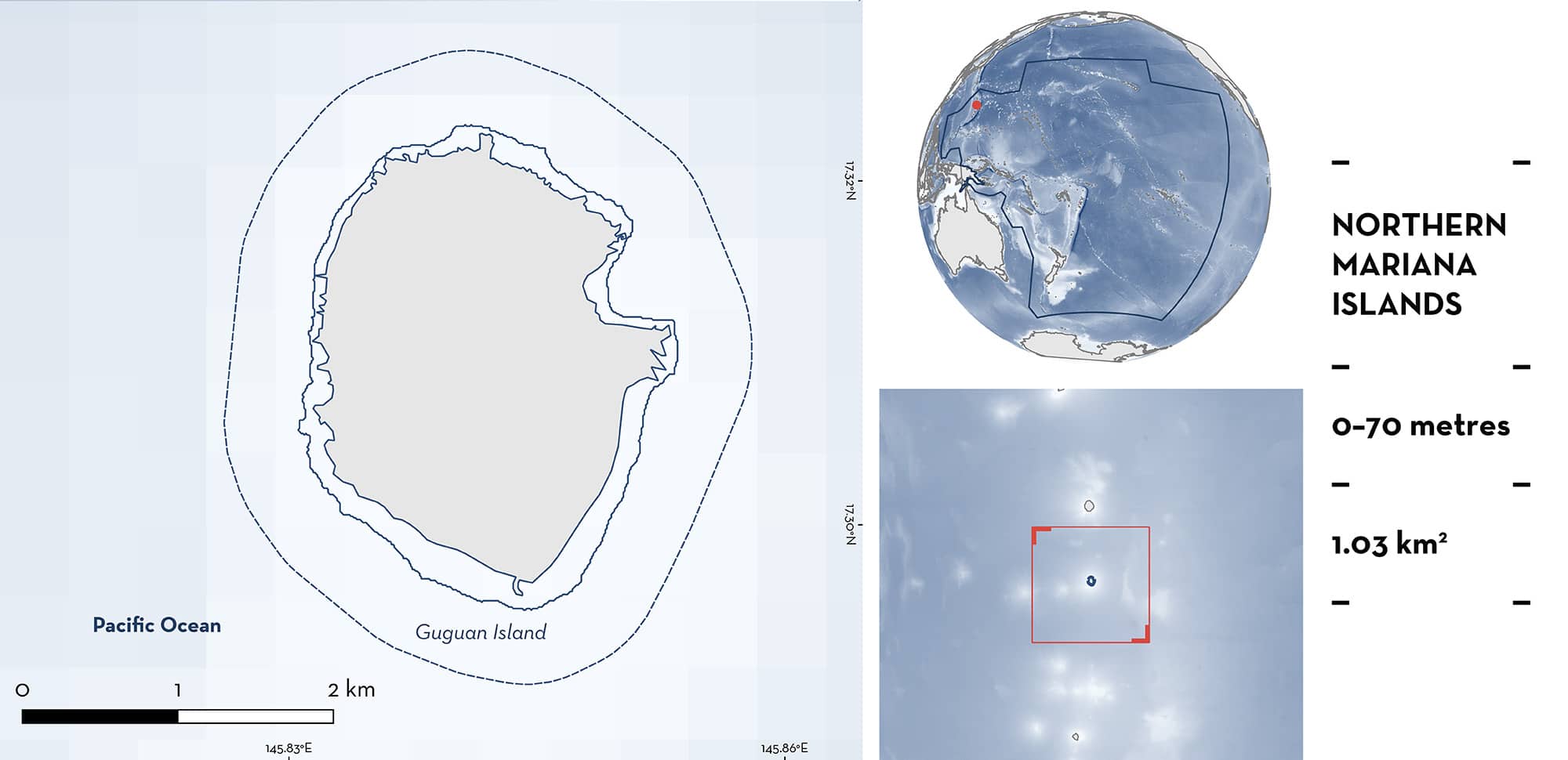ISRA FACTSHEETS
ISRA FACTSHEETS
NEW ZEALAND & PACIFIC ISLANDS REGION
Guguan Island
Summary
Guguan Island is located in the middle part of the Mariana Arc in the northwestern Pacific Ocean. It is part of the Commonwealth of the Northern Mariana Islands, a self-governing commonwealth in association with the United States of America. It is a dormant volcanic island. This island has one of the lowest salinities of the Northern Mariana Islands where unique species assemblages exist. It is characterised by coral with developing reefs that have carbonate deposits. Within this area there are: threatened species and undefined aggregations (Tawny Nurse Shark Nebrius ferrugineus).
Download factsheet
Guguan Island
DESCRIPTION OF HABITAT
Guguan Island is located in the middle part of the Mariana Arc in the northwestern Pacific Ocean. It is part of the Commonwealth of the Northern Mariana Islands, a self-governing commonwealth in association with the United States of America. Guguan Island is an isolated and uninhabited volcanic island formed from two volcanoes (Brainard et al. 2012). The habitat is mostly coral, with developing reefs that have carbonate deposits but lack a fully formed three-dimensional structure. There are also large rocks with a reef matrix made from coral skeletons cemented by coralline algae, and high-relief structures with carbonate foundations that are well-colonised by marine life (Houk & Starmer 2009). In the northeast and northwest regions, the seabed is characterised by steep slopes and narrow ridges. The highest sand cover is observed around the southern point of the island (Brainard et al. 2012). The coastal waters around the island have one of the lowest salinities of the Northern Mariana Islands where unique species assemblages exist (Houk & Starmer 2009).
This Important Shark and Ray Area is benthopelagic and delineated from surface waters (0 m) to 70 m based on the global depth range of the Qualifying Species in the area.
CRITERION A
VULNERABILITY
One Qualifying Species considered threatened with extinction according to the IUCN Red List of Threatened Species regularly occurs in the area. This is the Vulnerable Tawny Nurse Shark (Simpfendorfer et al. 2021).
CRITERION C
SUB-CRITERION C5 – UNDEFINED AGGREGATIONS
Guguan Island is an important area for undefined aggregations of one shark species.
Between 2009–2017, 15 towed-diver surveys (TDS) were conducted in the area: 2009 (n = 4 surveys), 2011 (n = 5), 2014 (n = 3), 2017 (n = 3) (CREP PIFSC 2017a, 2017b, 2017c). The TDS method involved two divers being towed behind a boat (~2.2 km track). The diver at ~15 m depth recorded the number, size (TL), and species of all fishes measuring >50 cm total length (TL) within a 20,000 km2 area (Brainard et al. 2012). Aggregations of Tawny Nurse Sharks were recorded in 2014 (n = 8 individuals) and 2017 (n = 4 individuals). These are the only aggregations of Tawny Nurse Sharks recorded in all 13 sampled islands from the Northern Mariana Islands by TDS in those years (CREP PIFSC 2017a, 2017b, 2017c). The number of Tawny Nurse Sharks per dive within this area was 1.13 while in the remaining 12 islands, ranged from 0–0.75 (average = 0.19) (CREP PIFSC 2017a, 2017b, 2017c). Tawny Nurse Sharks often have limited home ranges, display site fidelity, and aggregate in the shelter of caves and rocky crevices during daylight hours (Ebert et al. 2021). The ecology of Tawny Nurse Sharks and observations during surveys support the importance of this area for aggregations of this species. Further information is required to understand the function and nature of this aggregation.
Download factsheet
SUBMIT A REQUEST
ISRA SPATIAL LAYER REQUEST
To make a request to download the ISRA Layer in either a GIS compatible Shapefile (.shp) or Google Earth compatible Keyhole Markup Language Zipped file (.kmz) please complete the following form. We will review your request and send the download details to you. We will endeavor to send you the requested files as soon as we can. However, please note that this is not an automated process, and before requests are responded to, they undergo internal review and authorization. As such, requests normally take 5–10 working days to process.
Should you have questions about the data or process, please do not hesitate to contact us.


